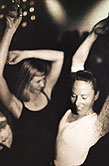
FRIDAY, April 18, 2014 (HealthDay News) — Whether you bust a move, get jiggy with it or just tap a toe or two, something about certain types of popular music makes you want to set your body in motion.
Now, a new study suggests that a medium amount of offbeat rhythm — often found in funk, hip-hop and electronic dance music — is just the trick to make you feel good and want to move your body in sync with the groove.
The study was small, with just 66 participants who listened to various types of drum breaks over the Internet and then answered questions about how the music made them feel. Still, the findings suggest that people seem to prefer music that surprises their brains and provides “a balance between predictability and complexity,” said study lead author Maria Witek, a postdoctoral research fellow with the Center of Functionally Integrative Neuroscience at Aarhus University, in Denmark.
The appreciation of music and ability to move their bodies in coordination with rhythm offers insight into what makes humans human. Some other creatures may be able to move in conjunction with music, but “as far as we know, humans are the only ones who synchronize to complex rhythmic structures, such as music, because it makes them feel good,” Witek said.
It’s not clear why evolution has created this ability, she said, but one theory is humans developed bonds with each other through playing music, listening to it, and dancing to it.
So what kinds of music make people happiest and most likely to get up and dance? The new study looked at “groove music” that makes people want to move and dance — to “groove.”
Witek points to examples of groove music like the song “Sex Machine” by James Brown and the new hit “Happy,” from the “Despicable Me 2” soundtrack, by Pharrell Williams.
Another expert noted some particularly groovy types of music.
In general, “classic R&B, Motown and funk are highly rated by listeners for grooviness, with Stevie Wonder’s music rating especially high,” said Justin London, a professor of music at Carleton College, in Northfield, Minn. But he added that older generations may have felt the same way about forms of music like big band — Duke Ellington, for instance.
In the new study, researchers contacted 66 participants via a survey on the Internet and asked them to listen to 50 brief drum breaks — drum solos — and answer questions about how much they enjoyed them and how much they made them want to move.
Medium levels of syncopation appealed to people the most. But what’s syncopation?
“It’s is a musical structure that violates rhythmic expectations,” study author Witek said. “Another way of describing syncopation is ‘offbeat rhythm,’ because the tones occur between the main beats, and not on them. Syncopations are examples of rhythmic complexity, because they disrupt the regularity of rhythm and create perceptual tension.”
London, the music professor, said examples of syncopation include the guitar riff from Santana’s “Oye Como Va” and the “I…can’t…get…no” section of “(I Can’t Get No) Satisfaction” by the Rolling Stones.
Why is it important to not have too little or too much offbeat rhythm? When there are lower levels, the music is predictable, Witek said. But when there’s too much, she said, “there is so much complexity that we can’t even make out where the beat is, and have no sense of regularity that can guide synchronized movements.”
London pointed out, however, that answers did vary, so “what is too much syncopation for me may be just right for you.”
What’s next for research? “We need to look at how people actually move to this music, how it affects their brains and whether there are cultural differences,” Witek said.
The study appears in the April online issue of PLoS One.
More information
The University of Washington has more about music and the brain.
Copyright © 2025 HealthDay. All rights reserved.

